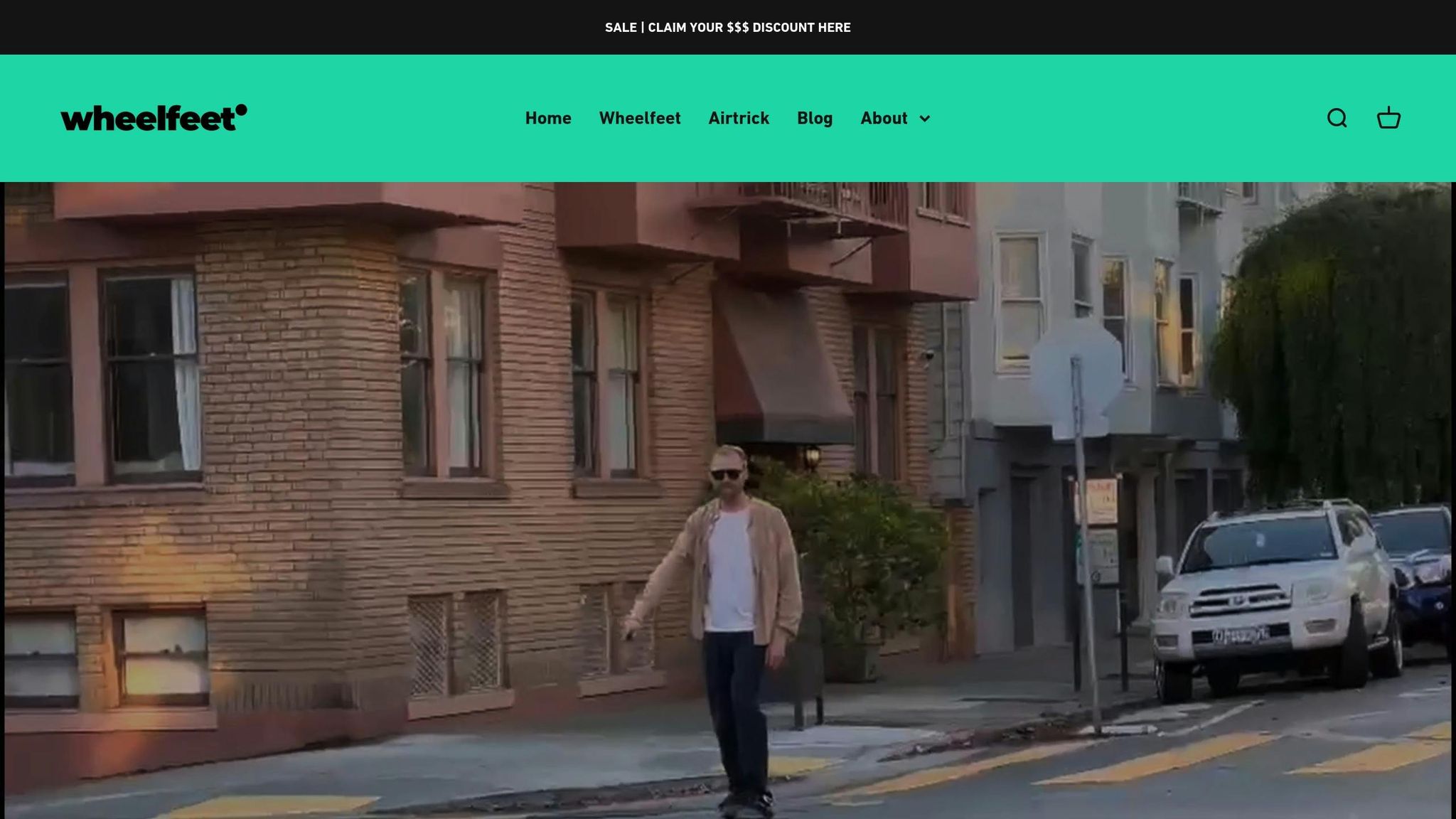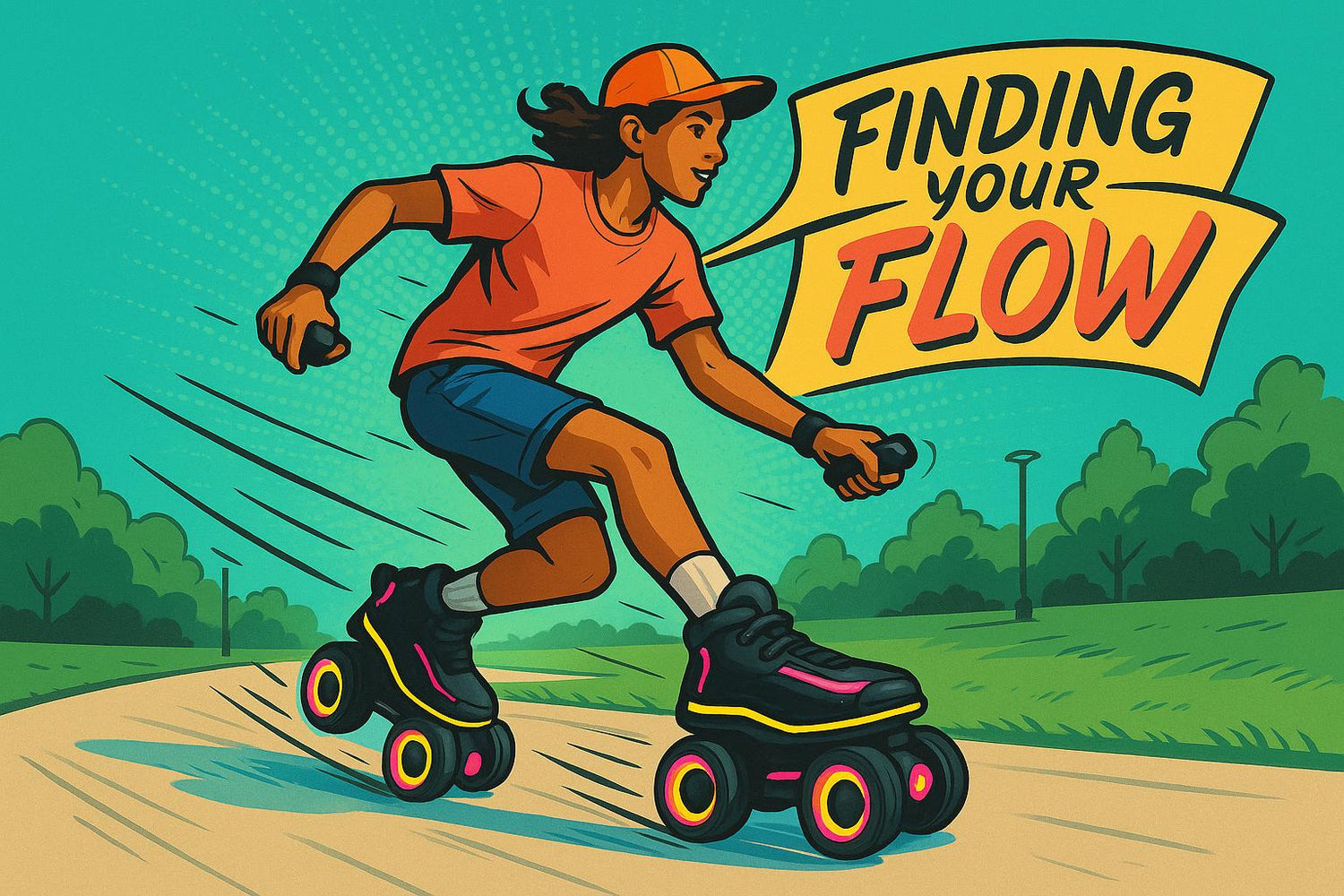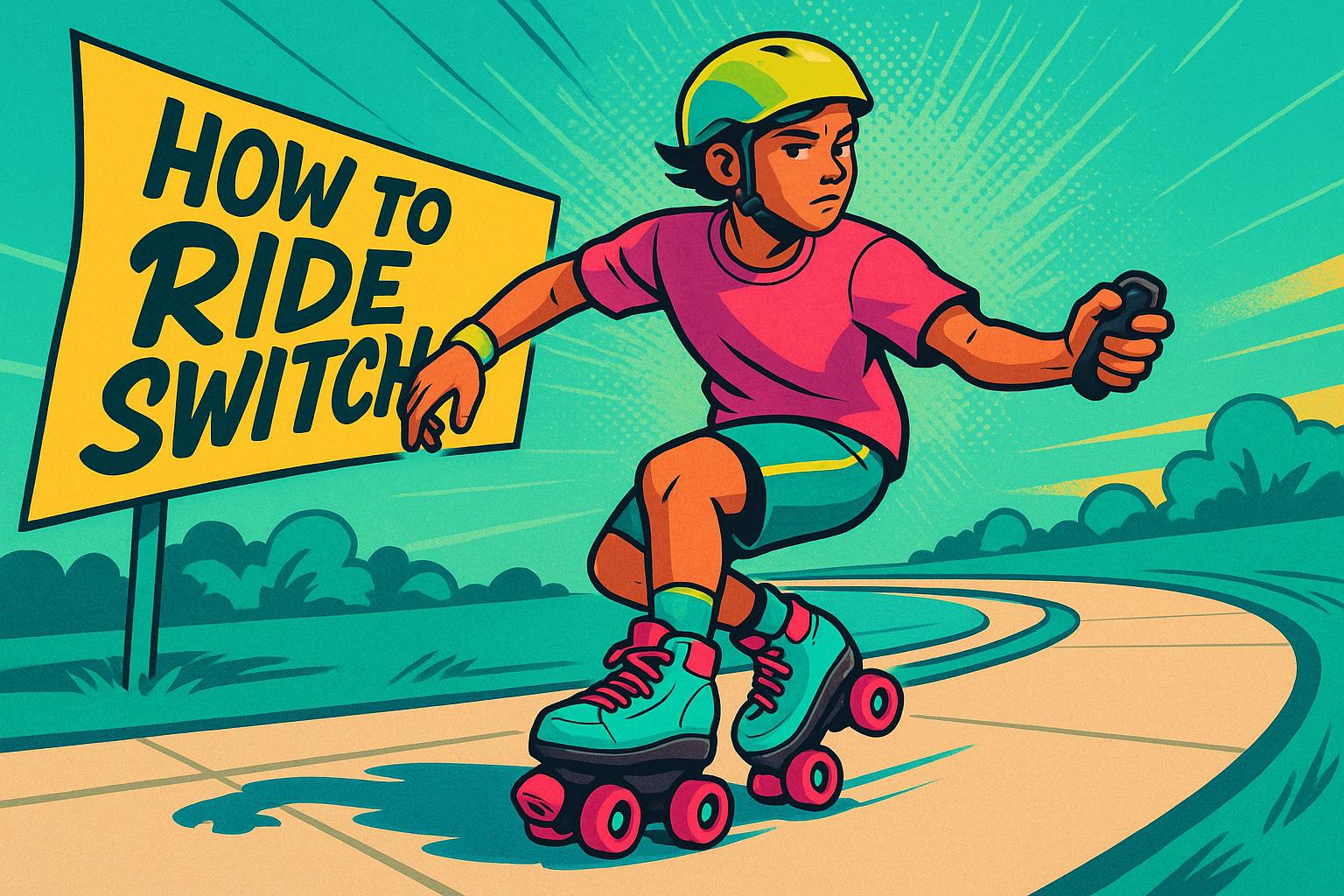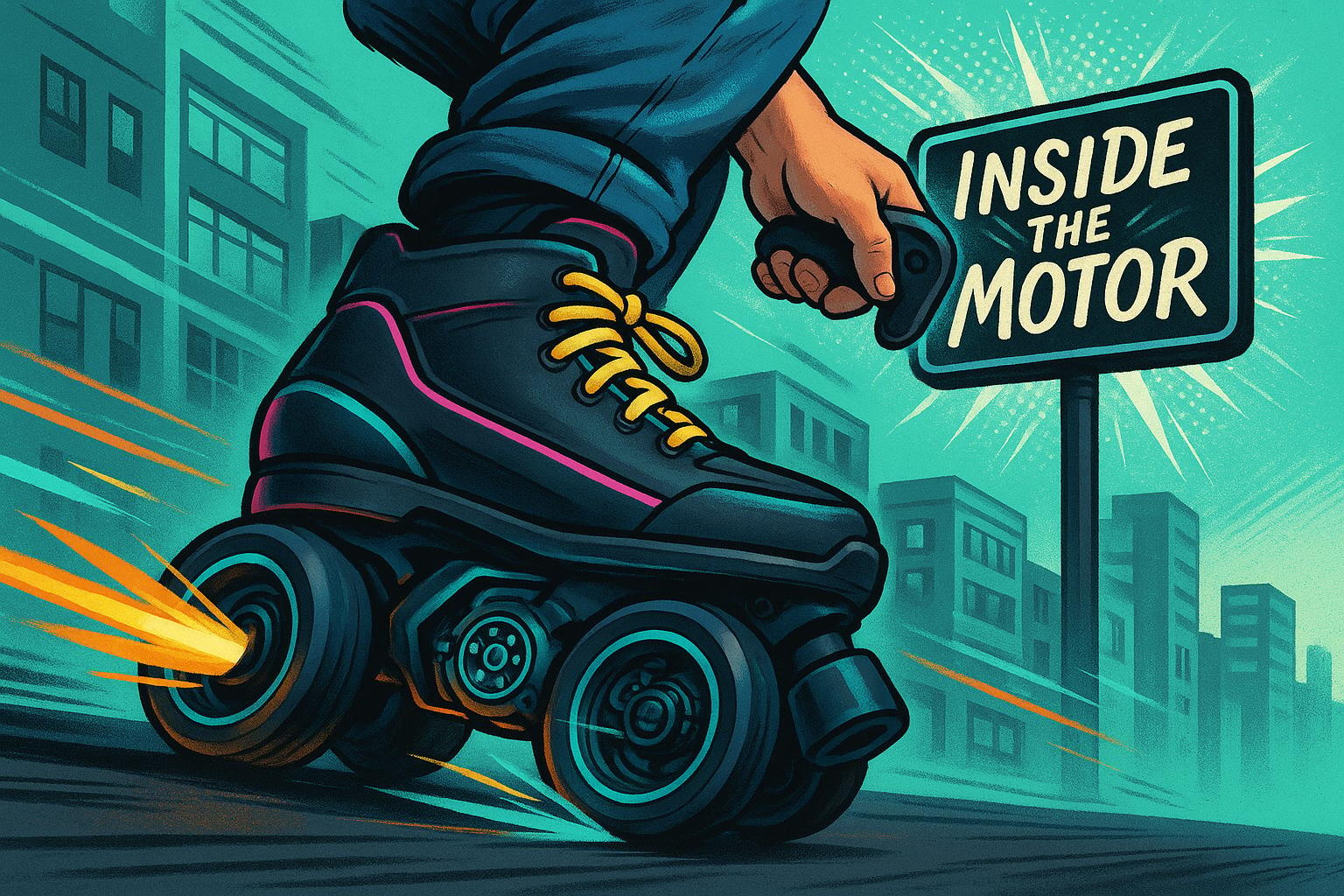Electric roller skating is transforming how we move, blending fun with practicality. Mastering carving and cruising is key to gliding with control and confidence. Here's what you need to know:
- Flow in Skating: Achieve smooth, natural movements for an effortless ride.
- Carving: Use S-shaped turns to manage speed and direction.
- Cruising: Maintain steady momentum with minimal effort.
- Gear: Wheelfeet skates offer speeds up to 15 mph, a 9-mile range, and regenerative braking for smooth stops.
- Safety: Always wear a helmet, wrist guards, and pads.
- Practice Tips: Start on flat surfaces, focus on balance, and gradually tackle slopes.
Whether you're a beginner or an experienced skater, these techniques and tools can elevate your skating experience.
How to Carve on Roller Skates | Trick Tutorial
Getting Ready: Gear and Safety Basics
Before you hit the pavement, make sure you’re equipped with the right protective gear, have your skates properly set up, and pick a safe spot to practice. This preparation will help you build confidence as you learn to ride.
Essential Protective Gear
Safety first! When you're starting out, wearing the right gear is non-negotiable. Here’s what you’ll need:
- Helmet: A snug, well-fitted helmet is your first line of defense for head protection.
- Wrist Guards: These help protect your wrists if you take a tumble.
- Knee and Elbow Pads: Falls happen, and these pads will save you from scrapes and bruises.
Investing in good-quality gear means you can focus on perfecting your balance and movements without worrying about injuries.
Setting Up Your Wheelfeet Skates

Getting your Wheelfeet skates ready is just as important as gearing up. Start by ensuring they fit properly - your skates should feel secure but still allow a bit of wiggle room for comfort.
Next, check the battery. A full charge means you can enjoy the full 9-mile range without interruptions. Begin with the lowest speed setting while you’re learning, and gradually increase it as you get more comfortable. Don’t forget to test the regenerative braking system in a safe spot to make sure it responds smoothly to your inputs.
Once your skates are good to go, it’s time to find the perfect practice area.
Picking the Best Practice Spot
Where you practice can make or break your learning experience. Start with smooth, flat surfaces like empty parking lots, sports courts, or bike paths. These areas give you plenty of space to focus on balance and turning without distractions.
Once you’ve nailed the basics, move on to gentle slopes to practice controlling speed and momentum. Look for smooth asphalt or well-maintained paths - they’ll make your ride much more enjoyable and help you improve your flow.
Learning Balance and Body Position
Now that you’ve got your gear ready and chosen a practice spot, it’s time to focus on balance and body positioning. These are the building blocks for smooth carving and cruising on your Wheelfeet skates. The way you position your body directly impacts how well you can control the skates, so getting this right from the start is crucial.
Finding the Right Stance
Start by positioning your feet shoulder-width apart to create a solid and stable base. Keep your knees slightly bent - this helps absorb shocks and gives you the flexibility to adjust to changes in speed or terrain. Make sure your weight is centered over the wheels; this will help you maintain balance and keep your movements smooth and controlled.
Weight Shifting for Control
Once you’ve nailed your stance, practice shifting your weight gently from side to side. These small, intentional movements are key to staying balanced while accelerating or turning. Over time, incorporating balance drills can help you fine-tune your control and boost your confidence on the skates.
Getting On and Off Safely
When starting out, practice riding slowly on a flat surface to build strength and improve your balance. When it’s time to stop, make sure you come to a complete halt before stepping off to ensure a safe dismount.
Carving Techniques for Smooth Riding
Now that you’ve nailed the basics of balance and body positioning, it’s time to elevate your Wheelfeet experience with carving. This technique turns a simple ride into a graceful dance of fluid motion. Building on your foundation of balance and stance, carving adds a new level of control and smoothness to your ride.
How Carving Works
Carving is all about creating smooth, S-shaped turns by shifting your weight from one edge to the other. Imagine drawing flowing curves in the air with your body - each movement transitions seamlessly into the next, giving your ride that effortless flow experienced riders love.
To carve, lean into the turns to manage both your speed and direction. Your Wheelfeet skates are designed to respond to these subtle weight shifts. When you press your weight onto your toes (toeside), you’ll curve in one direction. Shift to your heels (heelside), and you’ll carve in the opposite direction. This back-and-forth rhythm creates the wave-like motion that defines carving.
As you get the hang of it, you’ll notice you can control your speed without relying heavily on braking. Wider carves naturally slow you down, while tighter carves help maintain your momentum.
Basic Carving Moves
Start with toeside carves by gently shifting your weight forward onto the balls of your feet while leaning into the turn. Keep your knees bent and your core engaged to guide the skates smoothly through the curve. You’ll feel the skates naturally follow your body’s lead.
Next, work on heelside carves by shifting your weight back toward your heels and leaning into the opposite direction. This move might feel a bit awkward at first, but with practice, you’ll gain the balance and control needed for sharp, clean turns. While heelside carves can be trickier for beginners, they’re essential for creating those signature S-turns.
Once you’re comfortable with both, try linked S-turns. This is where carving truly comes alive. Practice connecting your toeside and heelside carves into a continuous flow, letting each turn naturally transition into the next. Start with wide, gentle curves and gradually tighten them as your confidence builds.
Practice Drills for Building Skills
Mastering carving takes practice, and targeted drills can help refine your technique.
- Find a gentle hill with a safe runout area to practice. Repeated runs on a gentle slope help you build muscle memory and improve your speed control. This consistent environment allows you to focus purely on technique without worrying about unexpected obstacles.
- Work on your non-dominant side to develop balanced control. Spend extra time practicing the turns that feel less natural - this effort will reward you with better overall control.
- Experiment with different surfaces once you’re confident. Try carving on grass, gravel, or dirt. Each surface challenges your body to adapt, improving your ability to handle varying terrains.
- Incorporate balance exercises into your routine. A strong sense of balance enhances your carving precision, especially on uneven ground. Simple drills, like practicing your stance or shifting weight while stationary, can make a noticeable difference.
- Maintain a low center of gravity by keeping your knees bent and your weight centered over your skates. This stable position allows for smoother transitions between turns. For added stability during longer carving sessions, try a staggered stance with one foot slightly ahead of the other.
Lastly, don’t underestimate the role of your arms. Let them move naturally with your body’s rhythm to help steer and maintain momentum through your carves. With practice, these small adjustments will make your carving feel second nature.
sbb-itb-bf837b9
Using Wheelfeet Features for Better Performance
Your Wheelfeet skates come packed with features designed to make carving and cruising more enjoyable. Learning how to use these tools effectively can elevate your riding experience, giving you the control and confidence to perfect those smooth S-turns you've been working on.
Adjusting Speed Settings for Your Skill Level
With Wheelfeet's wireless remote and Bluetooth app, adjusting speed is simple. You can switch between Low, Medium, Fast, and PRO modes, tailoring your ride to your skill level and the environment. The skates can reach speeds of up to 15.5 mph, offering flexibility for both beginners and seasoned riders .
If you're just starting to refine your carving technique, Low or Medium modes provide a steady balance of speed and control. As your skills improve and your linked S-turns become more fluid, Fast mode delivers a more dynamic carving experience. For those with advanced skills, PRO mode unlocks the skates' full potential, allowing for sharper, more responsive movements. Lower speeds give you the chance to focus on precise weight shifts and body positioning, while higher speeds let you glide through turns with ease. Pair these settings with regenerative braking to fine-tune your ride and keep your carving uninterrupted.
Using Regenerative Braking for Smooth Stops
The regenerative braking system on Wheelfeet skates isn't just about stopping - it’s about control. This feature allows for smooth deceleration while recharging your battery, giving you precise handling for both minor adjustments and full stops.
The wireless remote lets you control braking intensity, whether you need light braking to maintain speed on technical sections or stronger braking for confident stops. Every time you use regenerative braking, you not only gain better control but also extend your ride time - a win for riders dedicated to improving their technique. With speed and braking perfectly balanced, you’ll be ready to take on a variety of terrains with ease.
Riding on Different Surfaces
Wheelfeet skates are built to perform across a range of terrains, thanks to their durable wheels and sturdy aluminum frame. The dual-mode functionality lets you switch between electric and manual skating, adapting to the surface you’re riding on.
Smooth asphalt and concrete are ideal for practicing carving, offering consistent grip and predictable handling as you shift your weight through turns. Slight inclines become opportunities to test the motor's power and the skates’ adaptable speed settings, letting you focus entirely on your technique. Downhill sections are where regenerative braking really shines, helping you control your speed naturally while recharging the battery.
On rougher surfaces like bike paths or boardwalks, adjusting your speed mode ensures you maintain control. For grass or dirt, tweak your acceleration to keep up momentum while handling tighter, more controlled carves. On smoother pavement, you can enjoy wide, flowing S-turns. By matching your speed settings to the terrain and refining your carving technique, you’ll get the most out of your Wheelfeet skates no matter where you ride.
Advanced Tips: Improving Your Flow and Style
Once you've got the basics down, it’s time to level up your ride with drills designed to sharpen your control and enhance your flow. These exercises build on your core skills, helping you carve and cruise with greater precision and confidence.
Advanced Drills for Seasoned Riders
To refine your technique, focus on drills that highlight smooth transitions and accuracy. Try extended carving sessions in PRO speed mode, maintaining a consistent pace through long curves. Use subtle weight shifts to adjust your path, ensuring every movement feels deliberate. Mix things up by accelerating through turns and easing off the throttle on straight stretches. The regenerative braking system makes it easy to execute small corrections, helping you develop muscle memory for a ride that feels both seamless and controlled.
Conclusion: Finding Your Flow with Wheelfeet
Your journey from beginner to pro skater isn’t just about skill - it’s about the right mix of practice, patience, and the gear that helps you grow.
By now, you’ve explored the essentials: balance, weight shifting, and body positioning. These are the building blocks of smooth skating. You’ve also seen how refining your carving techniques can turn choppy movements into seamless, flowing rides.
Wheelfeet electric skates are designed to help you hone these skills. With speeds of up to 15 mph and a 9-mile range, they give you the freedom to practice wherever you want. Their regenerative braking system and adjustable speed settings allow you to build confidence at your own pace, making it easier to perfect your carving and stop with precision.
Beyond improving your skating, mastering these techniques offers a greener way to get around. Every smooth carve on your Wheelfeet skates contributes to a more sustainable and eco-conscious way of traveling.
Remember, progress comes with consistent effort. Start with the basics - focus on your stance and weight distribution - then move on to more advanced drills that strengthen your muscle memory. And thanks to Wheelfeet’s dual-mode functionality, you can keep practicing even when the battery runs low, blending manual and electric skating seamlessly.
So, strap on your Wheelfeet skates and carve out your own path with confidence and style.
FAQs
How can I improve my balance and body positioning while carving and cruising with Wheelfeet skates?
To get better at balancing and positioning your body on Wheelfeet electric roller skates, start by bending your knees slightly and distributing your weight evenly across both skates. This stance keeps you stable and ready to react to shifts in movement. Make sure to engage your core muscles - this adds extra control and steadiness, especially when you're taking turns.
When you're carving, lean gently into the turn, making sure your shoulders and hips are aligned with the direction you're heading. Start practicing on flat, smooth surfaces at a slower speed to build your confidence and train your muscle memory. With time and practice, you'll enjoy smoother, more controlled rides that feel natural and fluid.
How does the regenerative braking system on Wheelfeet skates work, and how can I use it to improve my ride?
The regenerative braking system on Wheelfeet skates offers a controlled and smooth way to stop while also recharging the battery, giving you more ride time. This feature isn't just about efficiency - it also boosts safety and gives riders more confidence, especially in situations where frequent stops are needed.
Using it is straightforward: press the brake button with your thumb to activate the regenerative braking. This slows you down gradually, helping you stay stable and in control. With a bit of practice, it’ll feel like second nature, making your rides not only safer but also more enjoyable.
What are the best places to practice carving and cruising on electric roller skates?
When you're choosing a place to practice carving and cruising on your electric roller skates, aim for smooth, open areas where you can focus entirely on your balance and technique. Ideal spots include empty parking lots, tennis courts, or even multi-level parking garages with light or no traffic.
It's important to pick a location that's clear of obstacles, pedestrians, and heavy traffic to keep things safe and distraction-free. Look for spaces where you can practice turns and maneuvers without interruptions. A smooth, open surface not only makes skating safer but also helps you build confidence and improve your skills.




Leave a comment
All comments are moderated before being published.
This site is protected by hCaptcha and the hCaptcha Privacy Policy and Terms of Service apply.